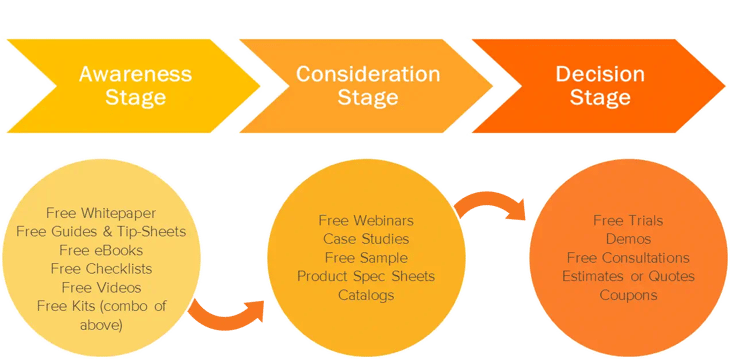What if your product is awesomesauce, but your customers just don't know they need you?
The struggle is familiar for many brands. Even if your products or services fill a critical gap in the market, you may feel that you're struggling against a lack of prospect knowledge. This factor is especially likely to occur for companies with unique service offerings. However, here's where it gets really frustrating.
If your customers don't know they need you, you can't market to them.
Research of the buyer's journey indicates that awareness is the first step towards making a purchase. Before customers start searching for product or service providers, they know they have a problem. They might not be able to articulate what they need, but they know what they're trying to solve.
How to Increase Brand Awareness

image credit: HubSpot
If your customers haven't reached the awareness stage of the buyer's journey, they're not actively looking for you. Perhaps they're not aware of the problem, or they're not sure how to get started looking for a solution. Regardless, if your brand awareness is poor or non-existent, talking about your solution won't make a difference. In this blog, you'll learn why content marketing is a crucial component of brand awareness -- and how to use content to educate prospects who don't have a clue how much they need you.
Why Content Matters to Brand Awareness
"Brand awareness is the probability that consumers are familiar about the life and availability of the product," according to Management Study Guide. Consumers have a high brand awareness that GPS technology can help them avoid getting lost in a way that's generally more convenient than paper maps. Other products or services are far less well-known. When consumers realize they need to begin researching products, your brand's awareness levels can impact sales.
Research by McKinsey indicates that brands that consumers encounter early in the awareness stage are more than three times as likely to be purchased as their competitors. This is where effective content marketing comes in.
If you are able to educate your prospects about the problem and provide a solution, you can build trust early in the buyer's journey. In many cases, you can begin building brand awareness before the buyer's journey even begins. By educating your prospects throughout the awareness stage of the buyer's journey, you'll be top of mind when it's time to make a purchase.
Uber: A Brand Awareness Case Study
Uber is among the most famous examples of industry disruption to occur in recent years. For urbanites, using an app to catch a ride across town is now a habit. Five years ago, the idea was unheard of. Uber's on-demand, technology-driven services have significantly impacted the cab and limousine industries, and could be poised to further disrupt transportation in the future.
When Uber launched, they faced an awareness struggle. As far as their potential customers knew, they were perfectly happy using cabs. In order to acquire a customer base, Uber had to educate their customers about their solution and prove they were better than the alternatives.
HubSpot writes that Uber's approach to awareness-driven marketing was driven by leveraging promoters. By connecting with high-profile players in the startup and technology spheres, Uber was able to generate buzz on social media and in blogs.
While their approach wasn't necessarily right for everyone, it's a clear illustration of the struggle that many brands with poor awareness face. Your customers might not know that using an app to reserve a ride is more pleasant than waiting in the rain for a cab. Perhaps they don't know that your business continuity software could save their business.
How to Build Brand Awareness with Content
Regardless, content marketing for brand awareness requires a slightly different approach. Join us as we review some effective tactics for building awareness with inbound marketing.
1. Position the Need
Ultimately, your prospects are suffering because they're not using your products. Perhaps they're absorbing unreasonable risks. Maybe they're uncomfortable or inconvenienced. However, the first step towards content for awareness is to position the need.
Brand Positioning is the art of communicating a gap. Marketers must work to illustrate the difference between where their customers currently are, and where they should be. For a security software brand, this could involve communicating the financial and brand image risks for their prospects who fail to protect their data adequately.
Effective positioning of buyer persona need should hit most of the following factors:
- Be believable and appealing
- Illustrate the risks of your customer's current position
- Make your product understandable
- Position your product as unique
2. Let Your Customers Tell Your Story
Research on consumers indicates that modern buyers don't trust brands or marketing. They trust friends and family above all kinds of marketing, including content.
This trend is particularly strong among the 80 million consumers classified as Millennials, or born after 1980. Millennials are so skeptical they'll believe an Instagram celebrity or fashion blogger's endorsement above an unknown expert, like a Physician.
Uber, Dropbox, Gmail, and Evernote are four examples of disruptive brands who have heavily leveraged brand promoters in their awareness campaigns. By offering free samples or rewards to your existing customers, you can allow your clients to sell your benefits. Chances are, your prospects will listen.
Other examples of trust-driven awareness marketing can include:
- Case studies
- Videos
- Co-marketing with other brands
3. Hack Your Growth
Traditional content marketing tactics may not be the best approach. If your customers aren't already searching for your company on Google or social media networks, you could lack visibility. Taking a blended approach to content marketing could yield better results, particularly if you're able to gain exposure on other platforms.
Per HubSpot, Buffer quickly achieved visibility by creating a prolific guest blogging strategy. By creating and publishing 150 guest posts in a relatively short period of time, the brand achieved visibility in front of prospective customers.
Mint is another example of a brand that achieved rapid growth through an innovative approach to content marketing. Mint's target customer, young professionals, aren't typically the sorts of people who purchase finance software.
However, by aggressively creating high-quality content around almost every finance-related search query, Mint became a trusted resource for their future customers. By answering basic personal finance question, Mint developed a means to educate their customers on not only managing their money, but how personal finance could help.
Make Them Miss You
For brands whose products aren't an obvious solution, building brand awareness can be a challenge. In most cases, it requires some serious commitment, innovation, and the willingness to "hack" their content marketing by testing innovative approaches.
By using brand promoters, real people, and smart Need Positioning to tell your story, you can develop an audience. By working continually to build trust and illustrate your customer's needs, you can begin to develop awareness and an audience that's searching for your services.





